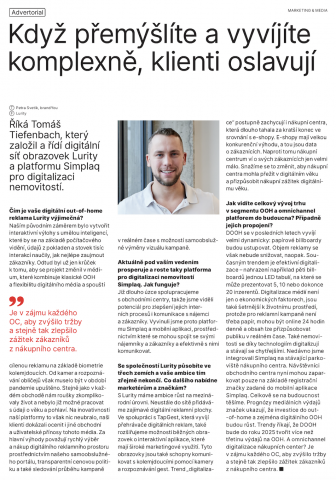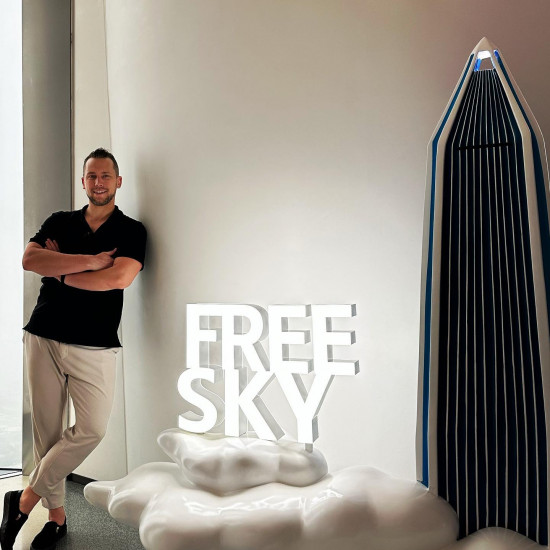
Tomas Tiefenbach is the founder of the digital OOH network Lurity and the inventor of several start-up projects, including the Simplaq platform for digitizing real estate.
DOOH Lurity has been on the market for 6 years and in that time has run almost 2,400 campaigns through the medium and the company has expanded into 3 countries. Simplaq is in its second year on the market and is also celebrating considerable success.
You manage the ambitious company Lurity, which combines the classic OOH medium and the flexibility of the digital medium. What is special about your digital out-of-home advertising?
TT:
Our original intent was to create interactive Artificial Intelligence (AI) shop windows that would learn how to best engage customers based on computer vision, POS data and hundreds of thousands of interactions. From there, it was just a step to turning the project into an interactive advertising platform where anyone who wanted to communicate a message quickly and effectively could advertise. The first location involved in the Lurity advertising network was the Bory Mall shopping centre in Bratislava.
However, cameras and facial recognition had to be abandoned during the pandemic period. As with any business, the veils made life more complicated for us and it was no longer possible to work with data on the age and gender of people who looked at our medium - the digital screen.
However, this hasn't detracted from the innovation of our platform, as our clients have proven to appreciate the business and user benefits of the medium other than just measuring viewership. They take as the main benefits the quick selection and purchase of digital advertising space via our self-service portal, transparent pricing policy and also real-time tracking of campaign progress with the possibility of self-service campaign visual replacement. In addition, our DOOH are available not only for larger brands and corporations, but also for smaller and small businesses that are sure to appreciate the high efficiency of the medium.
The Simplaq brand is currently growing and thriving under your leadership. It is a platform for the "digitalisation of real estate". How does such a platform work?
TT:
We have been working closely with shopping centres for a long time, so we saw the potential to improve their internal processes as well as their communication with tenants and customers. We therefore developed the Simplaq platform and mobile app, through which they are able to connect with their tenants and customers to communicate with them effectively. This platform facilitates them in various marketing and facility processes.
With Lurity, you operate in three countries and obviously your ambitions don't end there. What else will it offer marketers and brands?
TT:
With Lurity, we have big ambitions to grow internationally. We are constantly adding interesting digital advertising spaces to the network. In collaboration with TapGest, another innovative company that develops digital-signage players, we are also extending the capabilities of conventional screens with interactive applications that have broad marketing applications.
For example, screens and LED boards that were previously only able to play plain image and video campaigns are now able to play live-feed campaigns in which data changes in real time, which is appreciated by clients with active content, such as bookmakers, travel agencies, and the media, after connecting TapGest player thalations. These screens are also able to interact with passers-by using a camera and gesture recognition.
Shopping malls, which have long been on the short end of the stick compared to e-shops, are also gradually catching on to the "digitalisation" trend. And I don't just mean the pandemic years, when shopping malls were closed and people preferred eshops. Eshops have a major competitive advantage, and that is customer data. If you shop on Amazon or any other big online store, they know almost everything about you based on transactions. In contrast, a shopping mall knows very little about its customers. We're trying to change that so that shopping malls can survive in the digital age and adapt the shopping experience to the digital age.
How do you see the overall market evolving in the OOH segment and omnichannel platforms going forward? Possibly linking them together?
TT:
DOOH, especially in recent years, has developed very dynamically: paper billboards will gradually go by the wayside. However, the volume of advertising will not decrease, on the contrary - it will increase due to the growth of the economy. In the absence of technological progress, these market mechanisms would cause the price of a billboard to be enormous and smaller advertisers would be forced to switch to other advertising formats. The only solution to this situation is digitalisation - replacing e.g. 5 billboards with one LED board, on which 5, 10 or even 20 advertisers can present themselves.
The digitalization of media is not only about economic factors but also about their other benefits - they are more environmentally friendly as there is no need to cut down the forest for advertising campaigns as with paper billboards, they can be online 24x7 and the content can be adapted to the audience in real time.
Real estate is also going digital and becoming more smart thanks to technology. We recently integrated Simplaq onto an existing shopping mall parking lot. Visitors to the mall are now able to park using just the license plate number entered into the Simplaq mobile app and don't need paper tickets or to search for a parking meter.
All in all, we look forward to the future. Brand media spend forecasts show that investment in out-of-home and digital OOH in particular is set to grow. Trends say that DOOH will account for more than a third of OOH spend by 2025.
And omnichannel digitalisation of shopping centres? It's in every OC's interest to increase its revenue and equally increase the customer experience of the mall.

